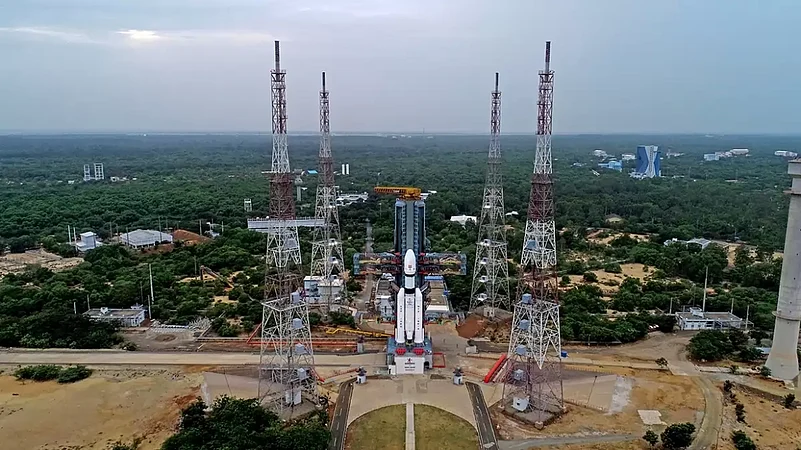Ahead of the launch of Chandrayaan-3 on Friday, excitement is building up across the nation as Indians celebrate one of independent India’s shining lights, the Indian Space Research Organisation. ISRO has been one of the few Indian agencies that has matched itself to its global peers, although on a shoestring budget. In light of the latest moon mission's launch today, Outlook recaps some of the biggest leaps forward that the Indian space programme has made, in its storied and remarkable history of milestone after milestone.
Chandrayaan-1, 2008
Chandrayaan-1 was India's first lunar mission. It carried various scientific instruments and made significant contributions to lunar research. The mission confirmed the presence of water on the moon's surface and discovered evidence of widespread water ice in the permanently shadowed regions of the lunar poles.
Mangalyaan, Mars Orbiter Mission, 2013
Mangalyaan was India's first interplanetary mission. It successfully reached Mars orbit in 2014 and became the first Asian nation to achieve this feat, beating its regional rival China amongst others to it. The mission primarily focused on studying the Martian atmosphere, surface, and mineral composition. It provided valuable data on methane presence and its seasonal variation on Mars, among other findings.
Chandrayaan-2, 2019
India's second lunar mission comprised an orbiter, lander (Vikram), and a rover (Pragyan). Although the lander faced a soft landing failure, the orbiter continues to operate successfully. Chandrayaan-2 aimed to study lunar topography, mineralogy, elemental abundance, lunar exosphere, and signatures of water ice. The mission's instruments detected evidence of water molecules on the lunar surface and also discovered several new lunar craters.
Gaganyaan
First conceived in 2007, but announced in 2018, Gaganyaan is a crewed orbital spacecraft intended to demonstrate the nation's human spaceflight capabilities, conduct experiments in microgravity, and pave the way for future space exploration missions, and put Indian astronauts back in space. The target for the first crewed mission involved the development of a new spacecraft (after which the mission was named) which would carry a crew of two to three astronauts into low Earth orbit (LEO) and bring them back safely. The spacecraft was to be capable of sustaining the crew for a week in space. It was set for 2022 launch to coincide with the 75th anniversary of India's independence. However, due to technical challenges and the Covid-19 pandemic, the timeline was revised. The first crewed mission is now expected to take place in late 2023 or early 2024, although an ISRO source suggested that it would happen in 2025.
The Gaganyaan mission represents a significant milestone for India's space program. ISRO works alongside HAL and DRDO to continue developing it. It is intended to further national aspirations for space exploration, aiming to make India the fourth country in the world to achieve human spaceflight capacity after the United States, Russia, and China. It is also aimed to enhance India's technological capabilities in space and renew the interest of the country's youth in science and technology, and aerospace. Beyond its famous launches, rockets and eventual space ambitions like the Gaganyaan Mission, ISRO stands out for many other reasons.
Although ISRO operates on a shoestring budget, much was made of the cost of the Mars orbiter, Mangalyaan, which was built in 15 months for $75 million, less than the cost of an average Hollywood blockbuster. ISRO also does not adhere to the strict design and review audits like its counterparts at NASA, saving money. However, it has not avoided public criticism; whether spending money on a space programme, no matter how well it has shaped up, was justified, given the nation had much more pressing problems, like poverty, inequality and healthcare to deal with. Yet, ISRO has gone to great pains to point out that its goal has never primarily been space exploration and does not aim to surpass its foreign counterparts. It is, and has always been primarily an application and human development-focused space program, a long-term focus of the organisation which was set in stone by Vikram Sarabhai amongst many of its other visionary chairmen.
The organisation leads in remote sensing, and many of the major feathers in its caps come from the successful satellite programs it has run. Outlook looks at a few over the years:
INSAT series
The Indian National Satellite (INSAT) system includes a range of communication, weather monitoring, and broadcasting satellites. Notable satellites in this series include INSAT-3D, INSAT-3DR, and INSAT-3DS.
GSAT series
The Geosynchronous Satellite (GSAT) series consists of satellites used for communication, remote sensing, and meteorological applications. Prominent satellites in this series include GSAT-6, GSAT-7A, and GSAT-30.
Cartosat series
The Cartosat satellites are Earth observation satellites primarily used for cartographic applications, mapping, and monitoring. Notable satellites in this series include Cartosat-2A, Cartosat-2B, and Cartosat-3.
Resourcesat series
The Resourcesat satellites are dedicated to resource monitoring and management, including land and water resources. Resourcesat-1 and Resourcesat-2 are examples of satellites in this series.
These are just a few examples of the major launches and satellite missions undertaken by ISRO. Above and beyond the major launches and planetary probes, the focus on remote sensing has paid off big-time, with more tangible results for the average citizen. In fact, through its remote sensing and communication programs (IRS and INSAT), they help build essential infrastructure for the country. Then, there is disaster management. Of this, the best example is Cyclone Phailin which hit Odisha in 2013.
Then ISRO chairman K Radhakrishnan said that over 400 images collected by their satellites, including Kalpana and INSAT-3D, over the four days of the storm helped to save thousands of lives. They were able to use this input to accurately predict velocity, intensity and the exact dates of landfall. The death toll for the cyclone today stands at 45, a toll that many argue, without the timely inputs, could have numbered in the thousands.
Every time our space program makes the news much is made of yet another feather in its cap. ISRO has stood clearly amongst the world’s top space agencies, and is one of the country’s few premier institutions which continues to deliver, despite the challenges it faces, and being outmatched by their global counterparts. They have received the due nods, with their peers at NASA often appreciative of how shrewdly ISRO has operated, finding ways around roadblocks often impenetrable unless armed with deep pockets, and the requisite resources. They embody the spirit of “jugaad”, a time-honoured Indian institution.
A new crop of news articles will pepper feeds and headlines celebrating the organisation, with each launch and project that it clears. Yet very few turn the spotlight back on the organisation itself and its issues. Many have argued that one reason for ISRO’s success has been the foresight of another former visionary chairman Satish Dhawan, who chose to base its headquarters in Bengaluru, far from the influence of Delhi, which has allowed it a certain degree of freedom and autonomy in its operation.
It consistently produces results, but still faces criticism for its funding. The cost of the Mars orbiter in comparison to a Hollywood blockbuster went viral. What went missing was that the orbiter also cost a fifth of what the Statue of Unity cost. For the nation’s arguably most successful and consistent R&D program, ISRO scientists receive comparatively less perks to their peers at other PSUs like ONGC which have cultivated a reputation for being generous with their perks.
The fear of the ‘brain drain’ is very real and has been voiced by many senior officials and engineers at ISRO. For the longest time, the Performance Related Incentive System (PRIS) was in limbo, and now exists in a moth-eaten format, that the government regularly cuts increments on, even today. All of this only further incapacitates the organisation’s ability to incentivise the best and brightest to continue producing the results a proud nation celebrates, a prominent complaint that many personalities associated with ISRO have voiced through their books, and in television interviews and media articles.
They have done their bit, and continue to do so. As we celebrate them once again, maybe we should remember to do our bit for them too. Chandrayaan-3 will launch for the skies on Friday, further proving why they more than deserve it.


























